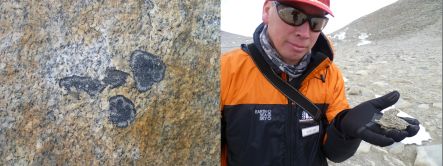
Glaciers in the southern Dry Valleys, and Jonathan Banks with a mummified crabeater seal (images: A. Ballance)
The Dry Valleys of Antarctica run between the eastern flank of the Trans-Antarctic Mountains and the Ross Sea. They are surrounded by ice, yet they are just bare rock - so dry for most of the year, that any snow that falls is 'sucked' into the air, through a process known as sublimation. For just a few brief weeks in mid-summer temperatures rise sufficiently to melt the glaciers, creating melt-water streams and lakes. This moisture is enough to allow terrestrial plants such as mosses and lichens, and invertebrates such as springtails and mites to live here, along with an abundance of soil microbes.

The Keyhole, and Mark Quigley with a boulder showing chatter marks formed by glacial ice. (images: A. Ballance)
Alison Ballance made a flying visit into the southern Dry Valleys to meet a multi-disciplinary team gathering data to feed into a complete ecosystem model to predict the distribution of terrestrial life. The team comprised spatial analyst Lars Brabyn, fellow Waikato University microbiologists Jonathan Banks and Ingrid Richter, and Canterbury University geologists Kurt Joy, Mark Quigley and Gregory de Pascale.

Crustose lichens in the Dry Valleys, and Kurt Joy with a cyanobacterial mat (images: A. Ballance)


